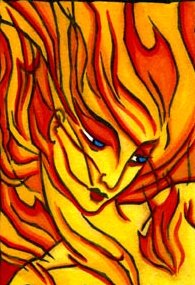Difference between revisions of "Incandesity"
Hawkestone (talk | contribs) |
Hawkestone (talk | contribs) |
||
| Line 18: | Line 18: | ||
Tàmhaire is considered to be the goddess of every flame, and as such held a great deal of importance. She is simultaneously goddess of the family hearth, campfires, bonfires, candlelight, smithy-fires, war blazes, controlled field-fires used to clear the land for planting -- and perhaps the most sacred flames of all, lightning strikes. In addition, she also rules over metalworking, blacksmithing, poetry, artistry, oration, brewing, warfare, and the culinary arts. | Tàmhaire is considered to be the goddess of every flame, and as such held a great deal of importance. She is simultaneously goddess of the family hearth, campfires, bonfires, candlelight, smithy-fires, war blazes, controlled field-fires used to clear the land for planting -- and perhaps the most sacred flames of all, lightning strikes. In addition, she also rules over metalworking, blacksmithing, poetry, artistry, oration, brewing, warfare, and the culinary arts. | ||
| − | The goddess is also considered to have a son, named | + | The goddess is also considered to have a son, named Shralann, whose overall symbol is smoke. Generally he is not usually depicted in image except in the most abstract of terms (i.e. smoke curls, smouldering cinders, etc). He represents obfuscation, shadows, mist, dimness (of mind as well as of light), the underworld, mystery, death -- and in modern times, the red tape involved in diplomacy and bureaucracy. |
== The New Faith == | == The New Faith == | ||
Incandesceity is a sophisticated renewal of this old belief system. Followers of the faith, known as the Incandesi, are no longer confined to the peasantry. The warmth, light and power of the goddess has expanded to illuminate and inspire the highest-ranking nobles in the kingdom. | Incandesceity is a sophisticated renewal of this old belief system. Followers of the faith, known as the Incandesi, are no longer confined to the peasantry. The warmth, light and power of the goddess has expanded to illuminate and inspire the highest-ranking nobles in the kingdom. | ||
Revision as of 07:14, 13 December 2006
Note: Incandesceity is a working title.
Introduction and History

|
| The Goddess Tàmhaire |
The faith of Incandesceity grew from an ancient unnamed pagan belief system that was held by many of the Northern Atamaran peasant families. An old tradition of these worshippers was to paint or carve a woman's face, framed by long hair, somewhere on or around the main fireplace of the household. A distinguishing feature of these female visage was that her long hair was always portrayed as floating upward, rather than hanging down. If they were asked about this feature (which was rarely), the response would be, "The Lady's hair is light."
As it turns out, this response was rather a clever pun. The portrayed Lady's hair was literally light -- light as in illumination, or more properly, flames. Another common descriptor for this image was, "the Lady with the light hair", or "the Lady with the shining hair". This Lady was a fire goddess, and as such, her upward-reaching hair represented licking flames.
This goddess's name was known as Tàmhaire, or, "Brilliant One". This was a half-pun on its own, as Tàmhaire is the goddess of not only fire, but also intelligence and inspiration. In the peasant language, inspiration means literally "the fire in the head" and as such any "bright ideas" are thought to originate as a spark from the sacred flame of the goddess.
Tàmhaire is considered to be the goddess of every flame, and as such held a great deal of importance. She is simultaneously goddess of the family hearth, campfires, bonfires, candlelight, smithy-fires, war blazes, controlled field-fires used to clear the land for planting -- and perhaps the most sacred flames of all, lightning strikes. In addition, she also rules over metalworking, blacksmithing, poetry, artistry, oration, brewing, warfare, and the culinary arts.
The goddess is also considered to have a son, named Shralann, whose overall symbol is smoke. Generally he is not usually depicted in image except in the most abstract of terms (i.e. smoke curls, smouldering cinders, etc). He represents obfuscation, shadows, mist, dimness (of mind as well as of light), the underworld, mystery, death -- and in modern times, the red tape involved in diplomacy and bureaucracy.
The New Faith
Incandesceity is a sophisticated renewal of this old belief system. Followers of the faith, known as the Incandesi, are no longer confined to the peasantry. The warmth, light and power of the goddess has expanded to illuminate and inspire the highest-ranking nobles in the kingdom.